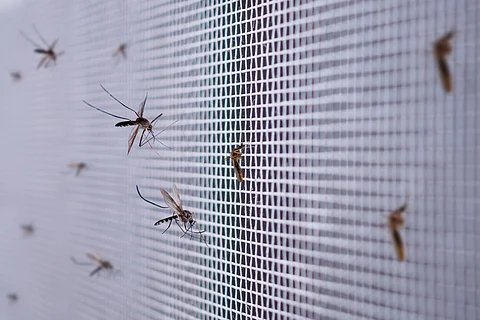

The World Health Organization (WHO) released its World Malaria Report 2024 on December 11, 2024, painting a sobering picture of the global malaria burden. The report highlighted a sharp rise in malaria cases and deaths, ongoing threats from drug and insecticide resistance and emerging challenges posed by zoonotic parasites and invasive mosquito species.
In 2023, malaria cases surged to an estimated 263 million across 83 countries, up from 252 million in 2022. This marks a significant increase from 226 million cases in 2015. Ethiopia, Madagascar, Pakistan, Nigeria and the Democratic Republic of the Congo accounted for the bulk of this rise, with Ethiopia alone reporting an additional 4.5 million cases.
Malaria deaths also climbed to 597,000 in 2023, compared to 578,000 in 2015, the report found. However, the mortality rate has shown a gradual decline since the COVID-19-induced spike in deaths in 2020. In 2020, the disruptions brought about by the pandemic triggered a significant rise in malaria-related deaths, resulting in an additional 55,000 fatalities.
No one should die of malaria; yet the disease continues to disproportionately harm people living in the African region, especially young children and pregnant women. An expanded package of lifesaving tools now offers better protection against the disease, but stepped-up investments and action in high-burden African countries are needed to curb the threat.
Tedros Adhanom Ghebreyesus, WHO director-general
Africa continues to bear the brunt of the disease, accounting for 94 per cent of global cases and 95 per cent of malaria deaths in 2023. Four countries — Nigeria, the Democratic Republic of the Congo, Niger and Tanzania — contributed over half of the region’s deaths.
Despite some progress under the “High Burden High Impact” (HBHI) initiative in 11 African countries, the region’s case incidence and mortality rates remain more than double the targets set by global strategies. From 2015 to 2023, case incidence declined by just 5 per cent, while mortality rates dropped by 16 per cent.
India’s fight against malaria saw some success, culminating in its official exit from the HBHI initiative in 2024. WHO noted sustained reductions in malaria incidence and mortality across its high-endemic states.
Between 2017 and 2023, estimated malaria cases in India fell dramatically, from 6.4 million to 2 million — a 69 per cent decrease. Deaths also saw a steep decline, from 11,100 to 3,500, marking a 68 per cent reduction over the same period. This progress was attributed to implementation of evidence-based strategies, including improved vector control, early diagnosis and effective treatment programmes.
Despite these advances, India accounted for half of all malaria cases in the WHO South-East Asia Region in 2023, highlighting the scale of its malaria burden relative to neighbouring countries. Indonesia followed, contributing just under one-third of the region’s cases. India’s approximately 2,038,000 reported cases represented 0.8 per cent of the global malaria burden in 2023.
The spread of partial resistance to artemisinin, a cornerstone of malaria treatment, has raised alarms, WHO underlined. Confirmed in Eritrea, Rwanda, Uganda and Tanzania, resistance is suspected in several other African countries, including Ethiopia and Sudan.
The global health agency has launched a strategy to curb this threat, stressing the need for urgent action to preserve drug efficacy.
Resistance to pyrethroids, the most widely used insecticides on mosquito nets, was reported in 55 of 64 monitored countries between 2018 and 2023. New-generation insecticide-treated nets have been recommended by WHO as a critical tool to combat this challenge.
The report also highlighted threats in combating malaria and found the invasive mosquito species Anopheles stephensi, which thrives in urban settings, has expanded its range to eight African countries.
Originally from South Asia and the Arabian Peninsula, Anopheles stephensi poses a significant threat to urban malaria control due to its insecticide resistance and adaptability to high temperatures.
Another concern is the spread of malaria parasites with HRP2 gene deletions, which compromise the accuracy of rapid diagnostic tests. These mutated parasites have now been detected in 41 countries, including Burkina Faso, Chad, Togo and Indonesia, the paper reported.
The rapid rise of P knowlesi parasite, which primarily affects Southeast Asia, is specially concerning. There were 3,290 cases due to P knowlesi in 2023, a 19 per cent increase from 2022. This zoonotic species complicates malaria elimination efforts due to its rapid onset and severe symptoms.
The report brought into focus the growing intersection between malaria and climate change, underscoring how rising temperatures and extreme weather events are exacerbating the global malaria burden.
Vulnerable populations, particularly in Africa, are increasingly exposed to the dual threats of climate-related disruptions and the high risk of malaria transmission.
Changing weather patterns and extreme climate events are intensifying the malaria crisis, WHO found. For instance, in Pakistan, unprecedented monsoon rains in 2022, likely aggravated by climate change, triggered widespread flooding and a subsequent fivefold surge in malaria cases compared to the previous year.
As extreme weather events become more frequent and severe, such outbreaks are expected to grow, posing significant challenges to malaria control efforts.
The paper also has a new chapter dedicated to addressing the needs of populations most vulnerable to malaria. Conflict, climate variability and migration continue to impede access to essential prevention, diagnosis and treatment services. Despite progress, many high-risk individuals remain underserved, leaving a critical gap in global malaria responses.
Between 2000 and 2023, an estimated 2.2 billion malaria cases and 12.7 million deaths were averted globally, with the African Region accounting for the lion’s share — 1.7 billion cases and 12 million deaths prevented. In 2023 alone, over 177 million cases and 1 million deaths were avoided worldwide. These achievements, however, are at risk as gaps in funding and resources threaten to undermine progress, the WHO warned.